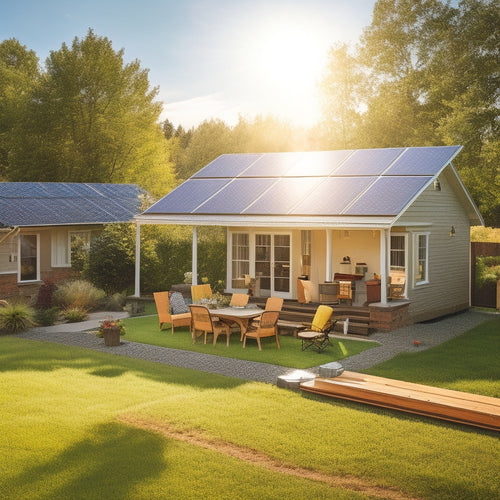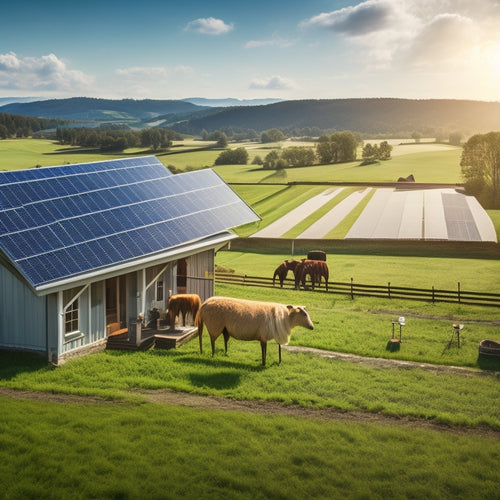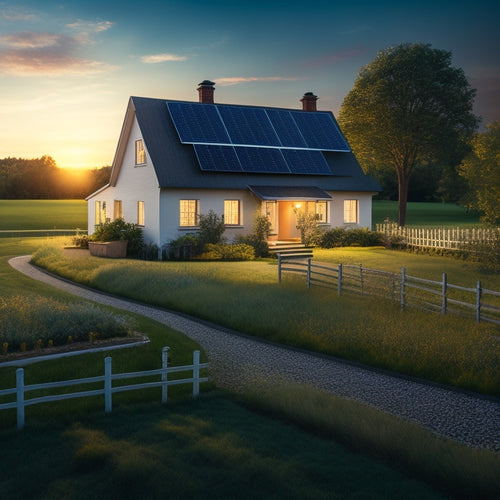
Integrating Solar Panels Into Office Building Design
Share
When integrating solar panels into your office building design, you're not only reducing your organization's carbon footprint and energy costs but also enhancing its overall sustainability. By evaluating your building's structural and environmental conditions, you can optimize energy collection and select the ideal solar panel layout. Evaluating your electrical infrastructure and using sustainable materials will also support your solar power integration. Consider factors like building orientation, roof space optimization, and solar panel aesthetics to guarantee seamless integration. By maneuvering through these design considerations, you'll be well on your way to utilizing the power of solar energy and realizing significant energy efficiency gains - but that's just the beginning of your expedition towards a more sustainable future.
Key Takeaways
- Evaluate the office building's structural and environmental conditions to optimize solar panel placement and energy harvesting.
- Ensure the electrical infrastructure can support additional power generation from solar panels and consider sustainable materials for minimal carbon footprint.
- Optimize roof space by assessing load-bearing capacity, panel orientation, and efficient placement strategies to maximize energy generation.
- Select solar panels that harmonize with the building's color scheme and design unique arrangements that serve as artistic installations, blending with the existing structure.
- Conduct thorough assessments and planning to overcome installation challenges, including structural support, shading analysis, and utility coordination.
Benefits of Solar Power Integration
Approximately 70% of commercial buildings in the United States consume a significant amount of energy, which contributes to greenhouse gas emissions and strains the national power grid. By integrating solar panels into your office design, you can reduce your reliance on non-renewable energy sources and minimize your environmental impact.
This approach to sustainable design not only benefits the environment but also provides you with energy independence and reduces your energy costs. You'll also benefit from government incentives and technological advancements that make solar power more efficient and cost-effective.
Additionally, solar panels can increase grid reliability by reducing peak demand during hot summer months. By incorporating solar power, you're contributing to a cleaner, more sustainable future, which can encourage community engagement and enhance your company's reputation.
With proper maintenance strategies in place, solar panels can provide a stable source of energy for years to come. Plus, their financial viability is increasing, making them a smart investment for your business.
Design Considerations for Office Buildings
As you consider integrating solar panels into your office design, it's crucial to evaluate the building's structural and environmental conditions to guarantee ideal energy harvesting. This includes examining the roof's size, pitch, and orientation to determine the best solar panel layout.
You'll also need to analyze the building's electrical infrastructure to make sure it can support the added power generation.
Next, consider using sustainable materials in your office design to minimize the building's carbon footprint. This can include materials with low embodied energy, recycled content, or sustainably sourced materials.
Additionally, incorporate daylight harvesting techniques to reduce the need for artificial lighting and further minimize energy consumption.
When selecting a solar panel system, choose one that's tailored for your office building's specific conditions. Consider factors such as energy output, durability, and maintenance requirements.
Building Orientation and Layout
What kind of building orientation and layout will allow your office to maximize its solar energy potential? To utilize the power of solar energy, you need to carefully consider the building's orientation and layout. A well-designed building can maximize sunlight exposure and reduce shading, resulting in increased energy production.
To optimize your building's solar energy potential, follow these guidelines:
-
South-facing orientation: Position your building to face directly south, allowing for maximum sunlight exposure throughout the day.
-
Shading analysis: Conduct a thorough shading analysis to identify potential obstructions, such as trees or neighboring buildings, and design around them.
-
Open floor plans: Incorporate open floor plans to reduce internal shading and allow natural light to penetrate deeper into the building.
- Minimal roof obstructions: Minimize roof obstructions, such as skylights or vents, to guarantee a clear surface for solar panel installation.
Roof Space Optimization Strategies
When designing an office building with integrated solar panels, you'll want to optimize your roof space to maximize energy generation.
This involves maximizing roof real estate by strategically allocating space for solar panels, considering obstacles like skylights, vents, and HVAC systems.
Maximizing Roof Real Estate
You're likely to have a significant amount of roof space available for solar panels, even on a smaller office building.
Maximizing this real estate is essential to generate the most power possible. To do so, consider the following strategies:
-
Assess roof load bearing: Verify your roof can support the weight of solar panels. Consult with a structural engineer to determine the maximum load capacity and choose solar panel types that fit within those constraints.
-
Optimize panel orientation: Position panels to capture the most sunlight throughout the day. A south-facing orientation is ideal, but you can still generate significant power with east- or west-facing panels.
-
Select high-efficiency panels: Choose solar panels with high energy output per unit area to maximize power generation in limited roof space.
- Consider a roof-mounted solar array: Instead of traditional rack-mounted systems, opt for a roof-mounted array that integrates seamlessly with your building's design.
Efficient Panel Placement
Five key roof space optimization strategies can greatly enhance your office building's solar power generation. To maximize energy output, you'll want to contemplate the following approaches.
First, optimize panel orientation. Panels installed at an angle between 15 and 45 degrees will capture the most sunlight.
Next, guarantee maximum sunlight exposure by placing panels in areas with minimal shading from surrounding structures or trees.
Third, contemplate a north-south panel layout to minimize mutual shading between rows.
Fourth, use a terrain orientation to reduce dust accumulation and facilitate cleaning.
Solar Panel Aesthetics and Integration
Considering the visual impact of solar panels on office design, builders and designers are now focusing on integrating these sustainable energy solutions seamlessly into building facades.
As you incorporate solar panels into your office building design, you'll want to guarantee they not only generate clean energy but also complement the structural style.
To achieve aesthetic harmony, consider the following design elements:
-
Solar panel colors: Choose panels that match or contrast with your building's color scheme to create a visually appealing facade.
-
Aesthetic materials: Select materials that blend with the existing structure, such as sleek and modern frames or integrated roofing systems.
-
Artistic installations: Design unique solar panel arrangements that double as art pieces, adding to the building's character.
- Facade adaptation: Integrate solar panels into the building's facade, guaranteeing a seamless shift between energy generation and architectural design.
Energy Efficiency and Cost Savings
You'll realize significant energy efficiency gains by integrating solar panels into your office design, reducing your energy consumption and subsequently lowering your operating costs.
By utilizing renewable energy, you'll not only minimize your reliance on the grid but also decrease your carbon footprint.
As you investigate the benefits of solar power, you'll find that the cost savings can be substantial, making an enticing business case for this sustainable investment.
Reduce Energy Consumption
By incorporating solar panels into office design, building managers can tap into a reliable source of renewable energy, thereby reducing their reliance on non-renewable energy sources and slashing energy consumption.
This is especially important as energy costs continue to rise, and companies are under increasing pressure to adopt sustainability practices.
To reduce energy consumption, you can:
- Conduct energy audits to identify areas of inefficiency and opportunities for improvement.
- Implement smart technology that monitors and controls energy usage in real-time.
- Improve building insulation to reduce heat loss and energy waste.
- Invest in energy management systems that optimize energy usage and provide performance monitoring.
Lower Operating Costs
As you integrate solar panels into your office design, you'll also reap the benefits of lower operating costs. By utilizing renewable energy from the sun, you'll reduce your reliance on traditional energy sources and lower your energy bills.
Effective energy management is key to maximizing these savings, and solar panels can be integrated into your existing energy infrastructure to optimize energy efficiency.
Financial incentives also play a considerable role in reducing operating costs. Governments and utilities often offer rebates, tax credits, and other incentives to encourage the adoption of solar energy.
These incentives can considerably offset the initial investment costs of installing solar panels, making them a more attractive option for businesses looking to reduce their operating expenses.
Carbon Footprint Reduction
The integration of solar panels into office design has a considerable impact on reducing your company's carbon footprint. By utilizing renewable energy from the sun, you can greatly decrease your reliance on non-renewable energy sources, ultimately reducing your company's contribution to greenhouse gas emissions.
Here are some key benefits of integrating solar panels into your office design:
-
Reduced energy consumption: Solar panels generate clean energy, reducing your company's energy consumption and reliance on the grid.
-
Lower emissions: By using sustainable materials and renewable energy, you can greatly lower your company's carbon emissions and environmental impact.
-
Improved brand reputation: By investing in sustainable office design, you can enhance your company's reputation and appeal to environmentally conscious clients and customers.
- Compliance with regulations: Integrating solar panels into your office design can help you comply with increasingly stringent environmental regulations and standards.
Overcoming Common Installation Challenges
Tackling installation challenges head-on is fundamental to successfully integrating solar panels into your office design. You'll need to maneuver complex installation logistics, starting with structural assessments to guarantee your building can support the added weight of the panels.
Regulatory compliance is also pivotal, as you'll need to meet local building codes and obtain necessary permits. A thorough shading analysis will help you identify the most efficient panel placement, while accessibility issues must be addressed to guarantee safe maintenance.
Utility coordination is essential to connect your system to the grid, and maintenance planning will help you budget for future repairs. Cost estimation and project timelines are significant to staying on budget and meeting deadlines.
Frequently Asked Questions
Can Existing Office Buildings Be Retrofitted for Solar Panels?
You can definitely retrofit your existing office building for solar panels, but you'll need to weigh the installation costs against the potential increase in energy efficiency, ensuring a profitable return on investment for your business.
How Do Solar Panels Affect Office Building Property Values?
You've likely seen a neighborhood where one house stands out, its solar panels gleaming like a badge of innovation. Similarly, your solar investment can enhance office building property values, generating energy savings that attract top tenants and increasing your asset's worth by up to 17%.
Are Solar Panels Compatible With All Roofing Materials?
You'll find that not all solar panel types are compatible with every roofing material; you'll need to take into account roofing considerations like weight, durability, and waterproofing when selecting panels, ensuring a secure and efficient installation that meets your energy needs.
Can Solar Panels Be Integrated Into Office Building Facades?
You can seamlessly integrate solar panels into office building facades, achieving ideal solar panel aesthetics and solar energy efficiency, by selecting panels that complement the building's design, materials, and structural requirements, while maximizing energy harvesting.
Do Solar Panels Require Frequent Maintenance and Repairs?
You'll find that solar panels require minimal maintenance, with occasional cleaning and inspections, which won't break the bank, considering the installation costs are offset by significant energy savings, making them a worthwhile investment for your office building's energy efficiency.
Conclusion
As you finalize your office building design, remember that integrating solar panels can greatly reduce your carbon footprint and energy costs. For instance, the Solar Ark building in Japan, a net-zero energy office building, incorporates 1,500 solar panels into its unique design, generating enough power to fuel 500 homes. By prioritizing solar power integration, you can create a sustainable and efficient workspace that sets a new standard for eco-friendly office design.
Related Posts
-

Steps to Prepare for Solar Installation
To prepare for solar installation, start by evaluating your current energy consumption and future needs to determine ...
-

Solar Power Systems for Rural Properties
Solar power systems offer a reliable and efficient energy solution for rural properties, allowing you to gain energy ...
-

Cost-Effective Solar Solutions for Rural Homes
Cost-effective solar solutions can alter your rural home by enhancing energy independence and slashing utility bills....


